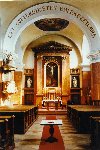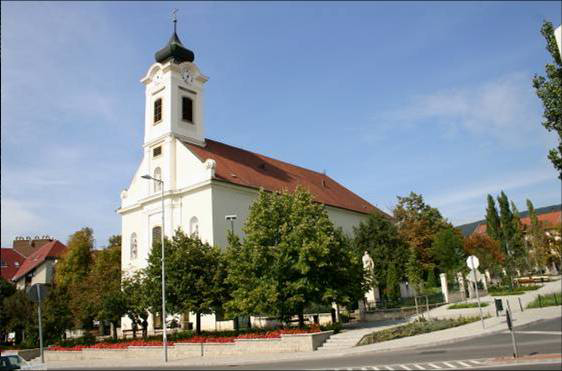 The altar of Saint Joseph located at the left wall of the nave has a Baroque
style, the two supporting figures, the father of the church and the nun are
good-quality sculptures, probably made by the Zichy family's own sculptor. The
figure of the opposite - right-side - John of Nepomuk with the surrounding
angels is a successful piece. The cingulum painted on the neck of the saint
indicates that he is a victim of the seal of confession. The altar of Saint
Sebastian at the right side of the nave is characteristic of the 19th
century. The two supporting figures - Wendelin of Trier and Roch - are the
saints of Budaörs. Wendelin is the saint of farmers and shepherds while the
classicizing figure of Roch, patron saint of the plague-stricken, reminds of
the epidemic in 1739. The dog fetching bread in its mouth reminds of helping
the plague-stricken. The predella of the altar has a successful painting of
suffering Christ. The main picture of the opposite, right-side altar depicts
Magdalena with Saint Elisabeth and Hungarian-born Scottish Saint Marguerite
next to her - both saints being protectors of the poor. Music-playing Baroque
angels of the organ-case remind of the angels, carved by Sebestyén Stuhlhof, of
the Tihany Abbey, and the organ used to be even richer in terms of figures
before it was rebuilt. The four fresco sections of the ceiling - John of
Nepomuk, Saint Dominic, the ascension of Christ and Moses with the snake on the
last fresco - show that the church used to be much more colourful. Moses could
very well be a symbol of Budaörs people looking for a new home. The small
Baroque tower of the church reminds of the first church.
The altar of Saint Joseph located at the left wall of the nave has a Baroque
style, the two supporting figures, the father of the church and the nun are
good-quality sculptures, probably made by the Zichy family's own sculptor. The
figure of the opposite - right-side - John of Nepomuk with the surrounding
angels is a successful piece. The cingulum painted on the neck of the saint
indicates that he is a victim of the seal of confession. The altar of Saint
Sebastian at the right side of the nave is characteristic of the 19th
century. The two supporting figures - Wendelin of Trier and Roch - are the
saints of Budaörs. Wendelin is the saint of farmers and shepherds while the
classicizing figure of Roch, patron saint of the plague-stricken, reminds of
the epidemic in 1739. The dog fetching bread in its mouth reminds of helping
the plague-stricken. The predella of the altar has a successful painting of
suffering Christ. The main picture of the opposite, right-side altar depicts
Magdalena with Saint Elisabeth and Hungarian-born Scottish Saint Marguerite
next to her - both saints being protectors of the poor. Music-playing Baroque
angels of the organ-case remind of the angels, carved by Sebestyén Stuhlhof, of
the Tihany Abbey, and the organ used to be even richer in terms of figures
before it was rebuilt. The four fresco sections of the ceiling - John of
Nepomuk, Saint Dominic, the ascension of Christ and Moses with the snake on the
last fresco - show that the church used to be much more colourful. Moses could
very well be a symbol of Budaörs people looking for a new home. The small
Baroque tower of the church reminds of the first church. The commemorative sculpture situated in the church garden - a soldier falling in the arms of Christ - was made by János Pásztor in 1925. Since June 1992, this has been supplemented by a row of inscriptions „In memory of our dead", placed ovally behind the sculpture and containing 16 tables with 475 names of people deported, displaced and died in World War II. The row of tables harmonising with the main sculpture was made by György Balassa, of Vörösvár, with the joint help of Budaörs people living in Germany and locals.



 German settlers built their first church between 1738 and 1752 at the location of the royal chapel from the Árpád Age. The present church was built between 1801 and 1810. Its patron saint is John of Nepomuk. Architectural styles of these two ages form a uniform internal space, Baroque-style details live together with classicising details.
German settlers built their first church between 1738 and 1752 at the location of the royal chapel from the Árpád Age. The present church was built between 1801 and 1810. Its patron saint is John of Nepomuk. Architectural styles of these two ages form a uniform internal space, Baroque-style details live together with classicising details.
